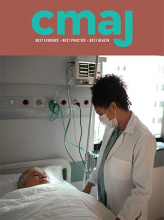Wang and colleagues provided a timely estimate of the sizeable surgical backlog in Ontario created by coronavirus disease 2019 (COVID-19) and the substantial investment of resources required to clear it.1 Osteoarthritis (OA) is associated with $1.4 billion annually in direct health care costs.2 With more than 137 000 hip and knee total joint replacements (TJRs) performed each year,2 patients waiting for TJR make up a sizable component of the COVID-19 surgical backlog. How best to optimize the health and quality of life for the thousands of individuals left in limbo while waiting for a rescheduled surgery? We propose that primary care clinicians, including physicians and physiotherapists, can work together to reduce pain and improve the quality of life for those with OA waiting for TJR.
International best practice guidelines for hip and knee OA strongly recommend patient education, exercise therapy and weight control (if necessary) as essential treatments.3,4 Even individuals with severe OA have the potential to improve their quality of life with comprehensive nonsurgical management.5 In a landmark study (MEDIC),5 patients with severe knee OA who were eligible for TJR were randomized to either TJR followed by 12 weeks of nonsurgical treatment, or 12 weeks of nonsurgical treatment alone. Nonsurgical treatment was delivered by physiotherapists and dieticians, and consisted of exercise, education, dietary advice, insoles and pain medication. While those who had TJR experienced greater improvements in pain and function, patients who received only nonsurgical treatment also had clinically significant improvements at 12 months and 75% had postponed their TJR at least 1 year.5 Unfortunately, however, only half of Canadians with OA receive comprehensive nonsurgical management.6
Physiotherapists, as experts in exercise prescription and chronic disease management, are key team members in OA management. Physiotherapists can deliver comprehensive evidence-based programs that are available across Canada and have been proven to reduce pain, and improve function and quality of life, such as Good Life with Osteoarthritis Denmark (GLA:D).7,8 Despite strong evidence, physiotherapy for knee and hip OA is rarely publicly funded, and Canadians must often use extended health insurance or pay out-of-pocket for these services. The pandemic has highlighted the urgency for local strategies to support and fund programs that connect OA patients in primary care to community-based physiotherapists for quality nonsurgical care.
In the time it will take to address the backlog of TJR procedures, evidence-based nonsurgical care of hip and knee OA can reduce pain and improve function and quality of life for those with the disease. Developing collaborative relationships between primary care clinicians in the management of OA in Canada will vastly improve the management of OA during the pandemic and lay stronger foundations for a culture of team-based primary care in the future.
Footnotes
Competing interests: Allison Ezzat is an instructor-trainer with the GLA:D Canada program.











